
Santa Maria Formation
Encyclopedia
The Santa Maria Formation is a sedimentary rock formation found in Rio Grande do Sul
, Brazil
. It has a late Ladinian
– early Carnian
age (Middle
– Upper Triassic), and is notable for its fossil
s of early dinosaur
s, including the herrerasaur Staurikosaurus
, the basal
saurischian Teyuwasu
, and the basal sauropodomorph
Saturnalia
. It received this name because it was discovered first in the city of Santa Maria.
The distinguished English
paleontologist Arthur Smith Woodward
determined the age of Santa Maria Formation dated Mesozoic
Era, Upper Triassic period (about 220 million years).
The Santa Maria Formation is in the geopark
of Paleorrota
.
.
Rio Grande do Sul
Rio Grande do Sul is the southernmost state in Brazil, and the state with the fifth highest Human Development Index in the country. In this state is located the southernmost city in the country, Chuí, on the border with Uruguay. In the region of Bento Gonçalves and Caxias do Sul, the largest wine...
, Brazil
Brazil
Brazil , officially the Federative Republic of Brazil , is the largest country in South America. It is the world's fifth largest country, both by geographical area and by population with over 192 million people...
. It has a late Ladinian
Ladinian
The Ladinian is a stage and age in the Middle Triassic series or epoch. It spans the time between 237 ± 2 Ma and 228 ± 2 Ma...
– early Carnian
Carnian
The Carnian is the lowermost stage of the Upper Triassic series . It lasted from about 228.7 till 216.5 million years ago . The Carnian is preceded by the Ladinian and is followed by the Norian...
age (Middle
Middle Triassic
In the geologic timescale, the Middle Triassic is the second of three epochs of the Triassic period or the middle of three series in which the Triassic system is divided. It spans the time between 245 ± 1.5 Ma and 228 ± 2 Ma...
– Upper Triassic), and is notable for its fossil
Fossil
Fossils are the preserved remains or traces of animals , plants, and other organisms from the remote past...
s of early dinosaur
Dinosaur
Dinosaurs are a diverse group of animals of the clade and superorder Dinosauria. They were the dominant terrestrial vertebrates for over 160 million years, from the late Triassic period until the end of the Cretaceous , when the Cretaceous–Paleogene extinction event led to the extinction of...
s, including the herrerasaur Staurikosaurus
Staurikosaurus
Staurikosaurus is a genus of herrerasaurid dinosaur from the Late Triassic of Brazil.-Discovery:The first known specimen of Staurikosaurus was recovered from the Paleontological Site Jazigo Cinco of the Santa Maria Formation in the geopark of paleorrota , Rio Grande do Sul, southern Brazil...
, the basal
Basal (phylogenetics)
In phylogenetics, a basal clade is the earliest clade to branch in a larger clade; it appears at the base of a cladogram.A basal group forms an outgroup to the rest of the clade, such as in the following example:...
saurischian Teyuwasu
Teyuwasu
Teyuwasu is a dubious genus of dinosaur from the Late Triassic. Named by Edio-Ernst Kischlat in 1999, little is currently known about this genus; the type species, T. barbarenai, was named from leg bones discovered in geopark of paleorrota, Brazil. The specific name honors Dr. Mário Costa...
, and the basal sauropodomorph
Sauropodomorpha
Sauropodomorpha is an extinct clade of long-necked, herbivorous, saurischian dinosaurs which includes the sauropods and their ancestral relatives. Sauropods generally grew to very large sizes, had long necks and tails, were quadrupedal, and became the largest animals to ever walk the Earth. The...
Saturnalia
Saturnalia (dinosaur)
Saturnalia is an extinct genus of basal sauropodomorph dinosaur known from the Triassic of Rio Grande do Sul, southern Brazil.-Discovery:Saturnalia was originally named on the basis of three partial skeletons...
. It received this name because it was discovered first in the city of Santa Maria.
The distinguished English
England
England is a country that is part of the United Kingdom. It shares land borders with Scotland to the north and Wales to the west; the Irish Sea is to the north west, the Celtic Sea to the south west, with the North Sea to the east and the English Channel to the south separating it from continental...
paleontologist Arthur Smith Woodward
Arthur Smith Woodward
Sir Arthur Smith Woodward was an English palaeontologist.-Biography:Woodward was born in Macclesfield, Cheshire, England and was educated there and at Owens College, Manchester. He joined the staff of the Department of Geology at the Natural History Museum in 1882. He became assistant Keeper of...
determined the age of Santa Maria Formation dated Mesozoic
Mesozoic
The Mesozoic era is an interval of geological time from about 250 million years ago to about 65 million years ago. It is often referred to as the age of reptiles because reptiles, namely dinosaurs, were the dominant terrestrial and marine vertebrates of the time...
Era, Upper Triassic period (about 220 million years).
The Santa Maria Formation is in the geopark
Geopark
A Geopark is defined by the United Nations Educational, Scientific and Cultural Organization in its UNESCO Geoparks International Network of Geoparks programme as follows:...
of Paleorrota
Paleorrota
Paleorrota , is a geopark located in the center of the Brazilian state of Rio Grande do Sul. The rocks and fossils found along the route date back to the times when there was only one supercontinent Pangaea....
.
Vertebrates
An unnamed prosauropod species is present in Rio Grande do SulRio Grande do Sul
Rio Grande do Sul is the southernmost state in Brazil, and the state with the fifth highest Human Development Index in the country. In this state is located the southernmost city in the country, Chuí, on the border with Uruguay. In the region of Bento Gonçalves and Caxias do Sul, the largest wine...
.
| Vertebrate Vertebrate Vertebrates are animals that are members of the subphylum Vertebrata . Vertebrates are the largest group of chordates, with currently about 58,000 species described. Vertebrates include the jawless fishes, bony fishes, sharks and rays, amphibians, reptiles, mammals, and birds... s reported from the Santa Maria Formation |
||||||
|---|---|---|---|---|---|---|
| Genus | Species | Location | Stratigraphic position | Material | Notes | Images |
Belesodon Belesodon Belesodon is a genus that was described by the species Belesodon magnificus.- Species:Belesodon magnificus, was the first cynodont found in the Santa Maria Formation in Paleorrota, Brazil. It was described by Friedrich von Huene in... |
Rio Grande do Sul. |
A synapsid. |
 |
|||
Pampadromaeus Pampadromaeus Pampadromaeus is an extinct genus of basal sauropodomorph dinosaurs known from the Triassic of Rio Grande do Sul, southern Brazil.-Discovery:... |
P. barberenai |
Rio Grande do Sul. |
|
"ULBRA Museu de Ciências Naturais da Fundação Zoobotânica do Rio Grande do Sul The Museu de Ciências Naturais da Fundação Zoobotânica do Rio Grande do Sul , is a Brazilian museum located inside the Porto Alegre Botanical Garden... -PVT016, disarticulated partial skeleton... including most skull bones" |
A basal Basal (phylogenetics) In phylogenetics, a basal clade is the earliest clade to branch in a larger clade; it appears at the base of a cladogram.A basal group forms an outgroup to the rest of the clade, such as in the following example:... sauropodomorph dinosaur. |
|
Saturnalia Saturnalia (dinosaur) Saturnalia is an extinct genus of basal sauropodomorph dinosaur known from the Triassic of Rio Grande do Sul, southern Brazil.-Discovery:Saturnalia was originally named on the basis of three partial skeletons... |
S. tupinquim |
Rio Grande do Sul. |
|
"[Three] partial skeletons, dentary, adult." |
A basal sauropodomorph dinosaur. |
|
Spondylosoma Spondylosoma Spondylosoma is a genus of archosaur of uncertain affinities from the late Ladinian-age Middle Triassic Lower Santa Maria Formation in Geopark of Paleorrota, Brazil. Recent studies have gone back and forth on its identity, suggesting rauisuchian or basal saurischian dinosaur... |
S. absconditum |
Rio Grande do Sul. |
|
"Various postcranial remains." |
Might not be dinosaurian. |
|
Staurikosaurus Staurikosaurus Staurikosaurus is a genus of herrerasaurid dinosaur from the Late Triassic of Brazil.-Discovery:The first known specimen of Staurikosaurus was recovered from the Paleontological Site Jazigo Cinco of the Santa Maria Formation in the geopark of paleorrota , Rio Grande do Sul, southern Brazil... |
S. pricei |
Rio Grande do Sul. |
|
"Partial postcranial skeleton with mandible." |
A herrerasaurid dinosaur. |
|
Teyuwasu Teyuwasu Teyuwasu is a dubious genus of dinosaur from the Late Triassic. Named by Edio-Ernst Kischlat in 1999, little is currently known about this genus; the type species, T. barbarenai, was named from leg bones discovered in geopark of paleorrota, Brazil. The specific name honors Dr. Mário Costa... |
T. barbarenai |
Rio Grande do Sul. |
|
"Right femur and tibia." |
Might not be dinosaurian. |
|
Trucidocynodon Trucidocynodon Trucidocynodon is an extinct, monotypic genus of synapsid from Upper Triassic of Brazil. Trucidocynodon riograndensis is the only species descript for genus.... |
T. riograndensis |
A synapsid. |
||||
See also
- PaleorrotaPaleorrotaPaleorrota , is a geopark located in the center of the Brazilian state of Rio Grande do Sul. The rocks and fossils found along the route date back to the times when there was only one supercontinent Pangaea....
- Caturrita FormationCaturrita FormationThe Caturrita Formation is a rock formation found in Rio Grande do Sul, Brazil. Its sediments were deposited in the Paraná Basin. The formation has a late Carnian to early Norian age and forms part of the Santa Maria Supersequence in the upper section of the Rosário do Sul Group.-Etymology:The...
- List of dinosaur-bearing rock formations

